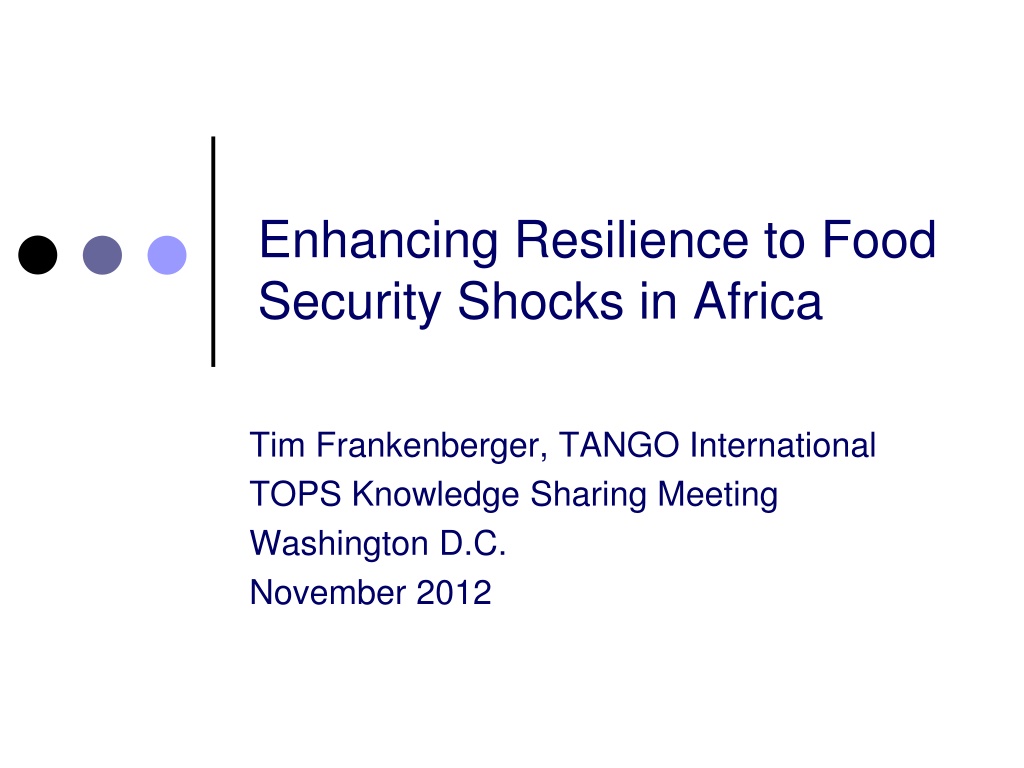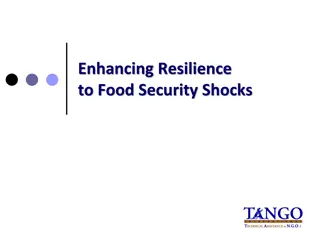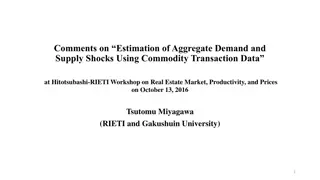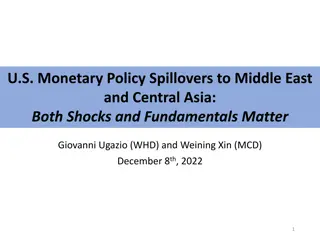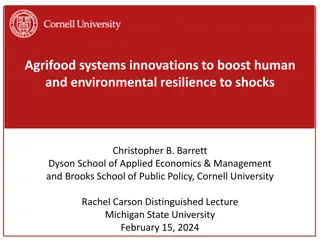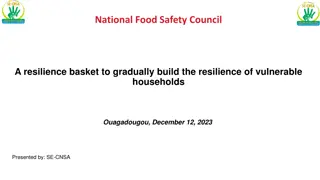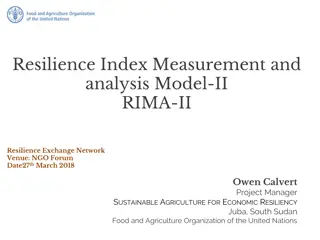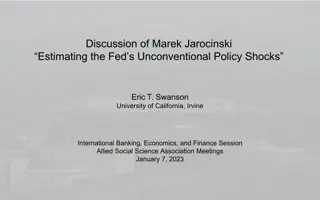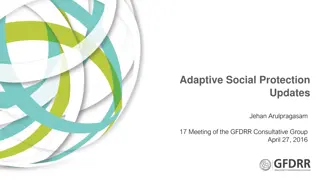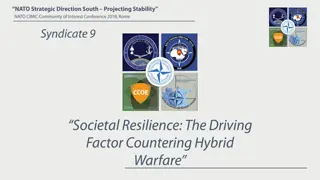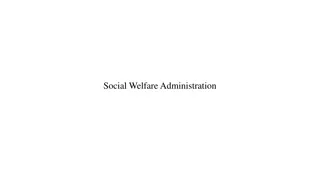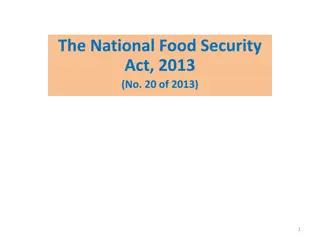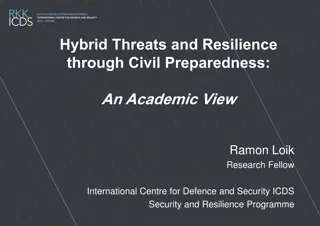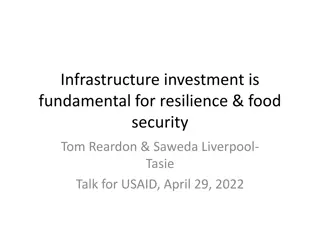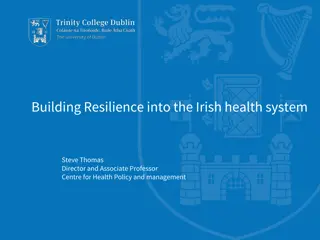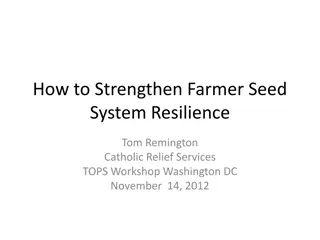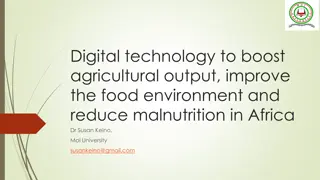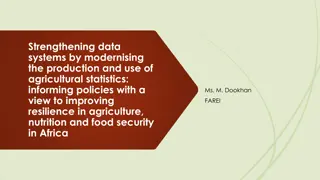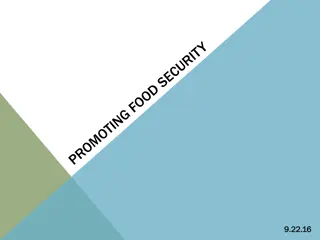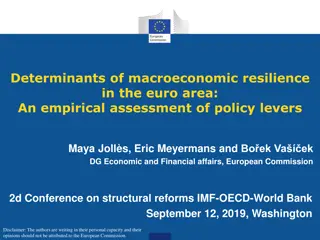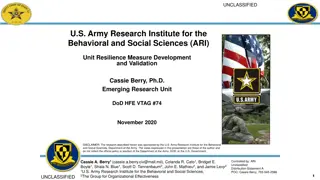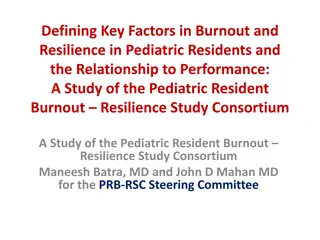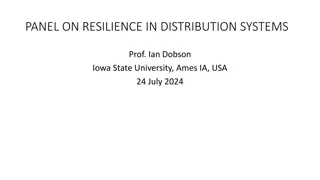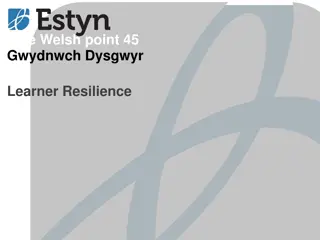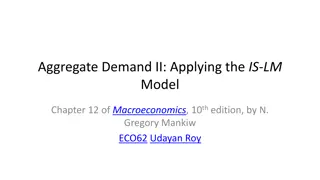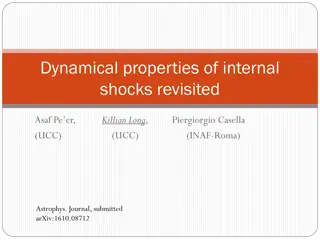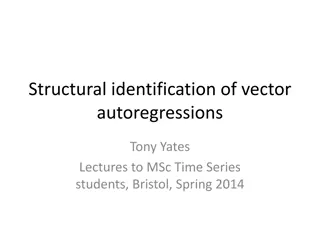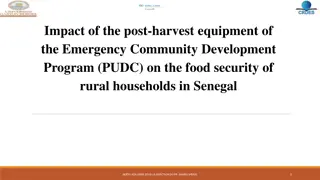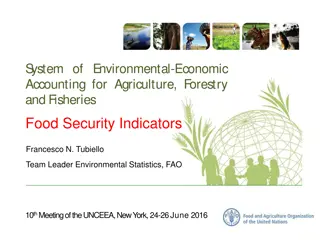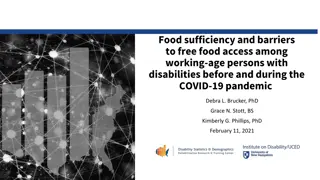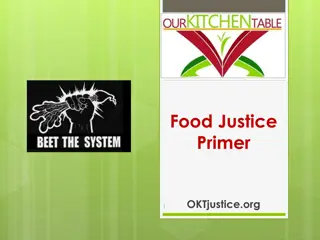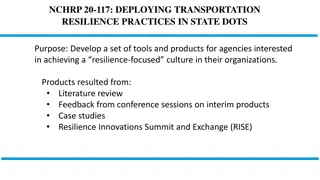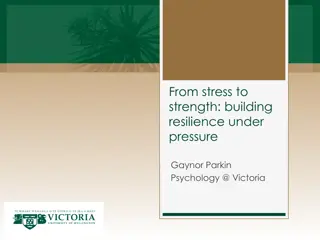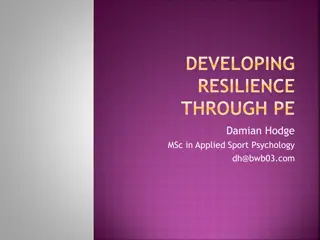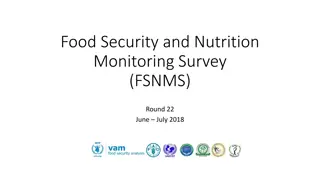Enhancing Resilience to Food Security Shocks in Africa
Enhancing resilience involves anticipating, adapting to, and recovering from hazardous occurrences in a way that protects livelihoods and supports development. Resilience is vital in regions facing continuous crises due to complex interactions of political, economic, social, and environmental factors. Strategies to enhance resilience vary based on different contexts. By improving resilience, communities can better address immediate and long-term challenges such as droughts, conflict, and price increases. This proactive approach minimizes the likelihood of shocks turning into disasters and enhances livelihood security.
Download Presentation

Please find below an Image/Link to download the presentation.
The content on the website is provided AS IS for your information and personal use only. It may not be sold, licensed, or shared on other websites without obtaining consent from the author. Download presentation by click this link. If you encounter any issues during the download, it is possible that the publisher has removed the file from their server.
E N D
Presentation Transcript
Enhancing Resilience to Food Security Shocks in Africa Tim Frankenberger, TANGO International TOPS Knowledge Sharing Meeting Washington D.C. November 2012
Defining Resilience The ability of countries, communities and households to anticipate, adapt to and /or recover from the effects of potentially hazardous occurrences (natural disasters, economic instability, conflict) in a manner that protects livelihoods, accelerates and sustains recovery, and supports economic and social development
Defining Resilience A resilient system has the capacity to respond positively to change, maintaining or improving function; this includes monitoring, anticipating and managing known risks and vulnerabilities to existing shocks and stresses while being able to address uncertainties in the future. Changes and responses may be incremental or transformational. IRWG 2012
Why Resilience? Continuous cycles of crisis in the Horn of Africa, the Sahel, south Asia; not enough time to fully recover between shocks Crises not the result of weather-related events only; complex interactions between political, economic, social and environmental factors Conflict and chronic poverty in many regions magnifies the impact of drought and other shocks Current drought crisis exposed shortcomings of international aid practices and national/regional policies
Why Resilience? Programming intended to enhance resilience is most necessary and appropriate where populations are chronically food insecure and are exposed to recurrent livelihood shocks and stresses Specific strategies for enhancing resilience will be as diverse as the different contexts in which they are implemented Improving resilience should not be defined by the what but much more by the why and the where
Resilience: a strategy for addressing immediate and long-term problems Given: droughts, conflict, price increases and other stresses/shocks are likely to continue Need for New Paradigm: climate change, political unrest, economic upheaval and other stresses/shocks do not need to become crises When people are able to anticipate, cope with and respond positively to changes/shocks, the likelihood of shocks becoming disasters is minimized and the prospects for future livelihood security are increased.
A conceptual Framework for Assessing Resilience Provides a comprehensive picture of the specific elements that contribute to resilience and clarifying the types of information that must be collected to measure it Helps determine whether households, communities and larger populations are on a trajectory towards greater vulnerability or greater resilience
Resilience Framework Context e.g., social, ecosystems, political, religious, etc. Disturbance e.g., natural hazard, conflict, food shortage, fuel price increase Adaptive capacity e.g., ability to deal with disturbance Adaptive state to shock Reaction to disturbance e.g., survive, cope, recover, learn, transform Livelihood Outcomes (-) Food Security Bounce back better Adequate nutrition Resilience pathway Level of aggregation Shocks Environmental security Structures/processes Livelihood Strategies Context Bounce back Sensitivity Livelihood Assets Exposure Food Insecurity Recover but worse than before Stresses Malnutrition Vulnerability pathway Environmental degradation Collapse ( + ) TANGO 2012. Adapted from DFID Disaster Resilience Framework (2011) , TANGO Livelihoods Framework (2007), DFID Sustainable Livelihoods Framework (1999) and CARE Household Livelihood Security Framework (2002)
Resilience Framework Context Environmental, political, social, economic, historical, demographic and policy conditions Affects and is affected by adaptive capacity (ability of HHs, communities, and governments to cope with shocks) Resilient systems are affected less by future shocks (feedback loop)
Resilience Framework Level of aggregation - Resilience of what/who? Level of Analysis: the individual, household, community, institution, government, ecosystem nested hierarchy, i.e., resilient individuals and HHs are the foundation for resilient communities Resilience at one level does not automatically result in resilience at higher levels, i.e., resilient households do not necessarily result in resilient communities
Resilience Framework Disturbance Resilience to what? Shocks Rapid onset: floods, earthquakes, disease outbreaks, conflict, food price increases Slow onset shocks: drought, food price volatility, environmental degradation Stresses (trends: Climate change, food price volatility, environmental degradation, political instability, disease outbreaks, population increases) Easier to mobilize resources for rapid onset shocks than slow onset shocks and stresses (sensational) Idiosyncratic versus covariate Resilience dependent on shock, i.e., no one-size fits all resilience
Resilience Framework Exposure a function of theduration, magnitude, and frequency of shocks Duration length of time that a shock lasts Magnitude the severity and extent of a shock Frequency how often a shock occurs; high frequency of the same types of shock undermines ability to respond Ability to manage shocks varies by communities, i.e., how many times a community has experienced the same type of shock may impact ability to respond Disaster risk reduction approaches are aimed at reducing exposure
Resilience Framework Adaptive Capacity Access to and use of resources and strategies in order to deal with disturbance Affect and are affected by contextual factors Livelihoods Assets Transforming structures and processes Livelihoods Strategies
Livelihood Assets Tangible and intangible assets allow households to meet their needs and objectives Livelihoods depend on a combination of six assets: Financial Physical Political Human Social Natural Most vulnerable households have fewer assets; least resilient
Transforming structures/processes Institutions operating within or have jurisdiction over community functions National, regional, local governments NGOs, CBOs Religious institutions Trade associations Shared customs and norms Formal/informal governance mechanisms to manage resources, target safety nets, mitigate conflict Government policies Crop/livestock insurance Access to Social protection (safety nets)
Livelihood Strategies Production/income generating activities Household resource investment strategies (e.g., small enterprises, savings, insurance) Risk reduction and risk management strategies Coping strategies - +/- strategies
Sensitivity Degree to which a unit (e.g., individual, HH, community) is able to cope with shock or stress due to access to assets, access to external support(safety nets, etc.) and livelihood strategies Limited adaptive capacity leads to high sensitivity Poor access to assets, income generating opportunities, and social safety nets, results in increased vulnerability Actors within a system vary in their sensitivity to the same shock (e.g., women, youths, elderly, children)
Reaction to Disturbance: Resilience Pathway vs. Vulnerability Pathway Households or communities that are able to use their adaptive capacity to manage the shocks or stresses they are exposed to are less sensitive and are on a resilient pathway. If they manage to improve their adaptive capacity by learning from the experience they are very resilient. Households that are not able to use their adaptive capacity to manage shocks or stresses are very sensitive and are likely to go down a vulnerability pathway.
Livelihood Outcomes These are the needs and objectives that households are trying to realize. If they are resilient, they will be able to meet their food security needs, they will have access to adequate nutrition, their environment will be protected, they will have income security, health security, and they will be able to participate in the decisions that affect their lives. If they are not resilient and are chronically vulnerable then they will likely be food insecure, malnourished, they will not have income security, they will be unhealthy, etc.
Resilience: A New Paradigm for Programming To enhance resilience, governments, donors, and implementing agencies should promote integrated strategies that ensure support for three separate but complementary components Adaptive Capacity Disaster risk management Governance and other enabling conditions
Resilience Outcomes Improved adaptive capacity Improved capacity to manage risks Improved development indicators Governance and Enabling Conditions for Achieving Scale - Support government ownership of resilience strategies - Promote responsive social and economic policies that support resilience - Strengthen administrative and technical capacity among key institutions to promote resilience programming - Advocate for formal social protection mechanisms (including emergency response, productive safety nets and risk insurance) - Provide basic social services (health, education, rule of law) - Support climate change adaptation - Promote national peace building and conflict resolution initiatives - Advocate for long-term funding for resilience initiatives - Improve national early warning systems and capacity for risk analysis - Improve access to productive infrastructure (roads, water, markets, communication) - Promote multi-sector partnerships across agencies (government, U.N. NGOs, private sector) Household and Community Adaptive Capacity - Promote diverse livelihood strategies Household and Community Disaster Risk Management - Strengthen and maintain informal safety nets - Promote asset accumulation and diversification - Support local peace building, conflict mitigation and natural resource management through informal governance structures - Improve human capital (health, education, nutrition) - Enable improved access to credit - Strengthen risk reduction, risk mitigation and risk coping mechanisms (community-based early warning, contingency plans, household savings) - Support smallholder market linkages - Improve access to technologies and potential for innovation - Strengthen diverse social networks - Strengthen capacity for community organization and collective action - Promote gender empowerment - Support for healthy ecosystems (land, water, biodiversity) Joint Problem Analysis Involving diverse stakeholders and contextualized at the sub-national level Multi-Sectoral Resilience Assessment Among chronically vulnerable populations exposed to food security shocks
Components of an Integrated Resilience Program Improving the Adaptive Capacity of Households and Communities Diversification of livelihood strategies, productive assets, and social networks Participation in well functioning markets Access to credit Access to innovative technologies Improved human capital (health, education, nutrition) Promote gender empowerment Support for healthy ecosystems (land, water bio- diversity)
Components of an Integrated Resilience Program Disaster Risk Management at the Household and Community Levels Disaster risk management strategies (ex-ante and ex post) Promote community-based early warning systems, contingency plans Promote household and community savings Support informal safety nets Contribute to peace-building and conflict mitigation Strengthen capacity for community organization and community action
Components of an Integrated Resilience Program Governance and Enabling Conditions for Achieving Scale Government ownership of resilience strategies Responsive social and economic policies that support resilience Formal social protection mechanisms (emergency response, productive safety nets, risk insurance) Improved access to infrastructure (roads, water, markets, communication) Multi-sector partnerships across agencies Provision of basic social services
Intensity of change/transaction costs stability flexibility change Absorptive coping capacity Adaptive capacity Transformative capacity (persistence) (incremental adjustment) (transformational responses) Resilience Source: B n , Christophe, Rachel Godfrey Wood, Andrew Newsham and Mark Davies. 2012. Resilience: New Utopia or New Tyranny? Reflection about the Potentials and Limits of the Concept of Resilience in Relation to Vulnerability Reduction Programmes. IDS Working Paper, Volume 2012 Number 405. CSP Working Paper Number 006. Institute of Development Studies (IDS) and Centre for Social Protection (CSP). September 2012.
Temporal Dimensions of 3 Resilience Outcomes Improved disaster risk management is aimed to improving absorptive capacity to reduce disaster risk and absorb the impacts of shocks short-term (stability) Strengthen the adaptive capacity to improve response to social, economic and environmental change in the medium term (flexibility) Strengthen governance structures and enabling conditions to improve the transformative capacity of socio-ecological systems to achieve resilience at scale in the long term (change)
Resilience programming requires: Projects implemented at scale and over long timeframes in order to have lasting impact. Projects that empower communities, i.e., promote community engagement, solidarity, ownership of resources, and capacity to organize. A shift from humanitarian responses to longer-term responses that build capacity to cope with current and minimize future stresses and shocks. Mechanisms for long-term funding (e.g., sequencing, layering, pre- positioning). Healthy ecosystems and effective governance structures.
Principles of Resilience Programming Promote resilience as a common perspective and a common objective with government ownership Prioritize selective and focused implementation of resilience building initiatives Commitment to integrated multi-sector approaches Support a transition toward longer-term investments in disaster risk management, climate change adaptation, livelihood diversification and social protection
Measuring Resilience M&E systems for measuring resilience involve in-depth analysis of indicators under three broad resilience outcomes: Improved capacity to manage risks coping strategy index reduction in emergency responses establishment of risk management structures institutions and systems
Measuring Resilience Improved adaptive capacity diversification of livelihood strategies and assets diverse social networks access to information on changing market and climatic conditions openness to new practices and innovation Aspirations Improved development indicators diet diversity nutritional status poverty outcome measures (proxies for income)
Promising Practices for Building Resilience Pastoral Livelihoods Initiative (PLI)and Prime Uses crisis modifier approach to fund support for improved livestock production and marketing, alternative livelihoods, and early warning systems. African Risk Capacity Project (ARC) Provides a framework to finance drought risk responses through the provision of fast-dispersing contingency funds to governments across Africa. PSNP + Combines food and cash transfers with market-oriented support to achieve beneficiary graduation. Lessons learned through PSNP+ will be scaled up through the Household Asset Building Program (HABP).
Moving the Resilience Agenda Forward Facilitate and promote political will to adopt approaches that are different that the past Agree on common objectives across agencies regarding building resilience Address immediate needs and longer-term development objectives simultaneously Seek consensus on contextually appropriate frameworks for resilience promote greater investment in resource poor environments by creating direct and indirect investment incentives for the private sector Cluster investments in social protection, disaster risk reduction, climate change adaption and market linkages in the same geographical areas
